
A couple of posts ago, I mentioned the concept of staging shots in nature and wildlife photography, and I’m finally getting back to tackling that as a subject. I’m going to attempt to throw some things out there for consideration without inserting too much personal opinion into the mix – we’ll see how that goes ;-)
While I don’t know if it has ever been measured by poll, I think most people believe that nearly all of the images they see of wildlife subjects have been shot on location and demonstrate natural behavior. Not only that, I think a large percentage actually bear some resentment towards the photo (or nature program) that is staged in some way. From experience in the field, and knowledge of lighting, behavior, and conditions that you’ll find these animals within, I can tell you that a hell of a lot more photos are staged in some way than most people think. For instance, most of the calendars showing owls, wolves, and the big cats are not shot in the wild. Most nature programs are staged either partially or completely, something that fans of The Crocodile Hunter and such really don’t want to hear, but seriously: do you think anyone, no matter how experienced, wanders up on animal subjects in the wild as often as these shows demonstrate?
There’s several debating points here. The first and biggest is, “Lying to your audience.” And I will readily agree that claiming that a staged shot or captive animal is actually “in the wild” is unethical. But, if you notice, most shows, calendars, photo credits, etc. make no such claim at all. They simply let you believe it, and take pains to hide the extra cameras, the edges of the set, the lights and reflectors, and all that. They imply a wild setting, but make no positive claims of such.
So, is implying unethical? Hmmm, good question. We are bombarded by it throughout our media, from commercials featuring “doctors” to every reality show out there, and everyplace in between. We’re happy with the suspension of disbelief that is required to get anything at all out of our entertainment. And in fact, there’s no small resentment when an actor that we like turns out to be a bigger asshole than the character they portray. There seems to be little argument, however, that we see nature photography and programs differently from, say, MTV’s “Real World.”
One can argue that nature photography can have a goal of demonstrating appearance, coloration, habitat, or behavior, and that staging doesn’t actually change this. Yes, it’s a closeup of an owl, one that it would be virtually impossible to achieve in strictly natural settings. But that doesn’t change the fact that it’s adorable! Yes, it’s perched on a real branch and has foliage in the background – that’s just part of the setting. Is this wrong, or deceptive? Does it have the same impact on us if it’s perched on the handler’s glove, or an obviously manmade perch? Is that difference all in our expectations?
Cost is an issue, too. Let’s say I want to see a hummingbird feeding its young. How many times have you seen hummingbird nests? I have yet to find any myself, even though I know there’s been one within a hundred meters of my place (because of the presence of a family at my feeder.) It might be a dozen meters off the ground, well hidden in a tree. Getting close enough for good detail shots means being in the trees near it, with a clear shot through foliage, and with adequate light to keep the images from blurring. Too close, and the hummingbirds aren’t going to like my presence, and might even abandon the nest. I might spend days to weeks at a time trying to get a couple of simple photos of feeding behavior.
Does this mean I can sell those images for a hell of a lot more money to an editor, because they’re genuine and took lots of effort to get? The chances are slim. Will the sponsors of a nature program pay a lot more for footage in natural conditions? Nope – there’s only so many commercials they’re going to stick in the program, and only so many viewers that these programs typically get, anyhow. Steve Irwin (The Crocodile Hunter) gained as many viewers as he did because he was an over-the-top character, and because people were waiting to see him get bitten. And while his show was one of the few that might have gained enough sponsor money to do everything in the wild, this was certainly not their approach.
So, how much “staging” is okay, and for what purposes? I’ve photographed hatching Ground Skink eggs in a terrarium – the behavior was natural, the setting was not. I’ve done plenty of shots at zoos – should this limit where and how those shots are used? For an article in a local newspaper or magazine about eagles, should any images be taken in the wild, or are these simply illustrations? Does the practice of setting out food and waiting for the photo subject to come by count as staging? And here’s a crucial question: would you pay more for a calendar of penguin photos that was guaranteed unstaged and natural? A whole lot more? And what counts as staging? Does habituating the animals to the presence of a photographer count?
I’m not leading anywhere with this, just providing some of the perspective. And of course, you should have guessed by now that, if I used that image at top for this post, it was staged – look closely and you’ll see the white of the bathtub peeking through the leaves. I tweaked the color and contrast to appear more like natural light conditions. The snake itself was quite wild, however – I had rescued it hours earlier from an old casting net it had become entangled within, and getting these shots earned me several bites and no small amount of juggling as it launched itself from the bathtub (not to mention cleaning the bathtub afterwards.) I was after detail and identifying markings, but is this an adequate excuse? And if I sell it, should there be specific markets I aim for?
[And if it helps, I usually make great effort to shoot in natural settings, and have never misrepresented an image. Just to put your mind at ease ;-) ]






















































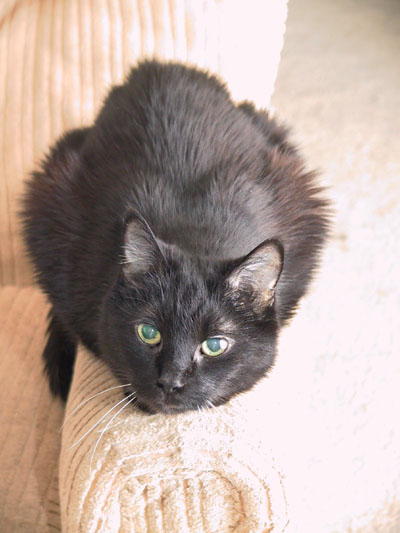 As I finish typing this, it will be April 15, 2010. My cat Ben, pictured here, turns eighteen years old.
As I finish typing this, it will be April 15, 2010. My cat Ben, pictured here, turns eighteen years old.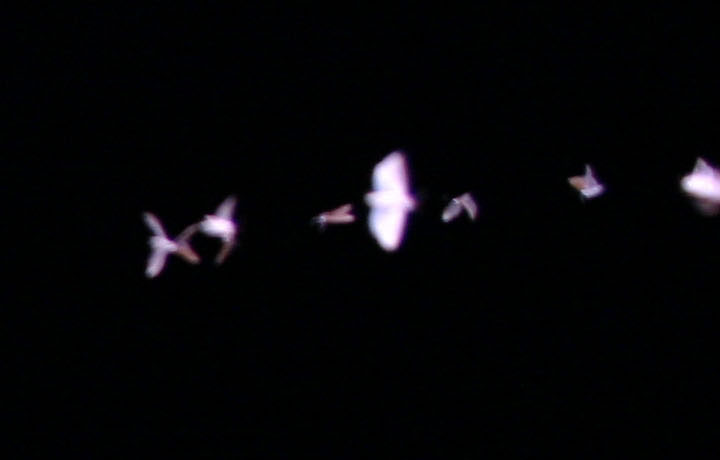
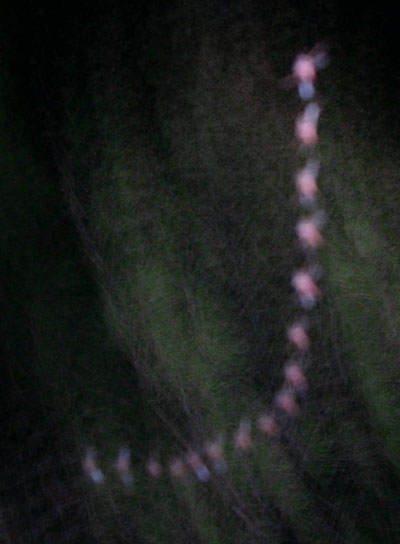 One other frame, at right, was also successful, to a small degree anyway, and this looks far more like a bat. Again, not in the focus range, but at least I got it better in the frame. The strange background is 16 successive images of the nearby tree, while not holding the camera steady (hey, it was bad enough even trying to see a bat in the dark, there was no way I’d get one to swoop nicely through the frame while the camera was on a tripod.)
One other frame, at right, was also successful, to a small degree anyway, and this looks far more like a bat. Again, not in the focus range, but at least I got it better in the frame. The strange background is 16 successive images of the nearby tree, while not holding the camera steady (hey, it was bad enough even trying to see a bat in the dark, there was no way I’d get one to swoop nicely through the frame while the camera was on a tripod.)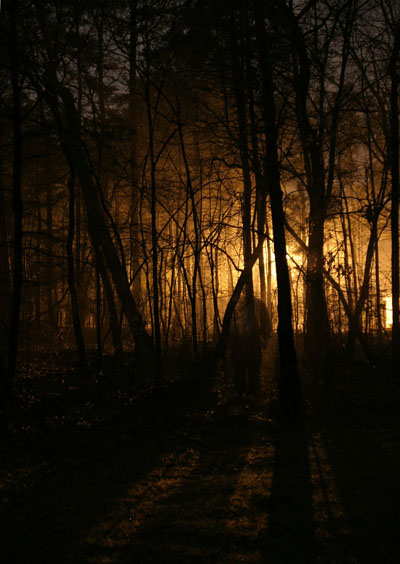 In the past couple of weeks, I’ve been doing little more than experimenting. One a foggy night recently, I went out to try and accomplish one of the images I’ve planned for just such conditions. As is often the case with these experiments, they didn’t come out quite as intended, meaning I’ll have to try again when we get a nice nighttime fog. But something else that I tried on a lark came out reasonably well, I think, though perhaps not as strongly at this size. I’ve been toying with posting it to some ghost forums just to see how much it can stir up – and how few can actually figure out that it’s a simple, and common, photographic effect. Technically, not a double-exposure, since it’s only one long exposure, but when your model (in this case me) isn’t in position for the entire exposure, a certain amount of light shows “through.”
In the past couple of weeks, I’ve been doing little more than experimenting. One a foggy night recently, I went out to try and accomplish one of the images I’ve planned for just such conditions. As is often the case with these experiments, they didn’t come out quite as intended, meaning I’ll have to try again when we get a nice nighttime fog. But something else that I tried on a lark came out reasonably well, I think, though perhaps not as strongly at this size. I’ve been toying with posting it to some ghost forums just to see how much it can stir up – and how few can actually figure out that it’s a simple, and common, photographic effect. Technically, not a double-exposure, since it’s only one long exposure, but when your model (in this case me) isn’t in position for the entire exposure, a certain amount of light shows “through.” As I was about to sit down to work on something tonight, it began pouring outside, and since we’ve had some nice warm weather recently, the frogs have come back out – someplace not far outside my window a treefrog started calling. I went outside with a pair of flashlights but still didn’t find it (little bugger got nervous as I got close and stopped calling,) but I did find a ladybug in not-so-typical conditions. I didn’t stay out long because it was raining too hard to do much photography, and both my jacket and the light camera bag are drying out now.
As I was about to sit down to work on something tonight, it began pouring outside, and since we’ve had some nice warm weather recently, the frogs have come back out – someplace not far outside my window a treefrog started calling. I went outside with a pair of flashlights but still didn’t find it (little bugger got nervous as I got close and stopped calling,) but I did find a ladybug in not-so-typical conditions. I didn’t stay out long because it was raining too hard to do much photography, and both my jacket and the light camera bag are drying out now.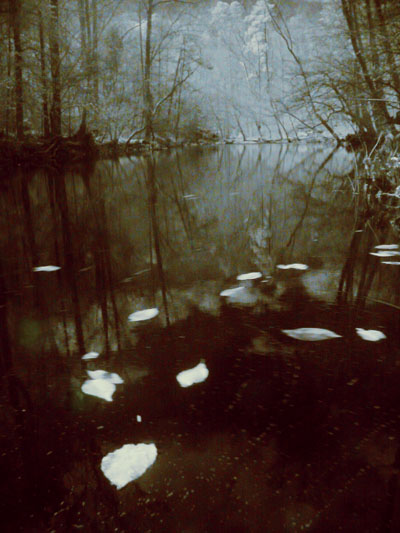 Oh, yeah, the contest! Anyway, this one has much more reasonable terms, so even though I have plenty in stock, I also started looking for potential shots that would fit their criteria better. Along the way, I was experimenting again, this time with infrared. I’ve talked about infrared on the site
Oh, yeah, the contest! Anyway, this one has much more reasonable terms, so even though I have plenty in stock, I also started looking for potential shots that would fit their criteria better. Along the way, I was experimenting again, this time with infrared. I’ve talked about infrared on the site 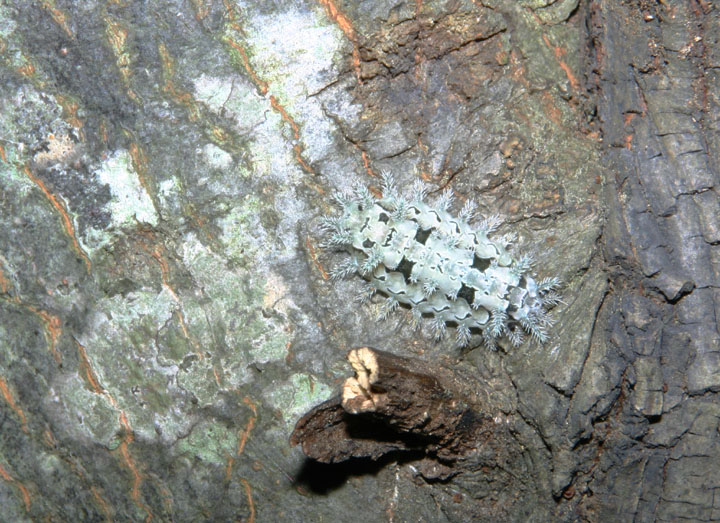
 Obviously, if the patterns of this little guy were randomly distributed, rather than so distinctive, it would have an even better form of camouflage. But to do this, the Hox genes would have to be very selectively inactive – enough to allow for color patterns to be asymmetrical, but not enough to produce six legs on one side and two on the other. That’s a very specific mutation. Moreover, for natural selection to favor it, it would have to generate some advantage (or, be common enough to carry while otherwise not being disadvantageous – neutral traits can continue too.) While we might think that asymmetry would help a lot towards not being recognized by predators, there isn’t much evidence that many predators are likely to recognize symmetry as a telltale. The color and the fuzzy shape may be enough. However, there are some other factors too. Many birds can see a much wider range of colors than we can, so even asymmetry might be a very minor factor against not matching the shade of lichens very closely. And this says nothing for how effective those little spines might be (I didn’t try to handle it,) or its scent or taste. So perhaps asymmetry simply didn’t have enough selective pressures to evolve.
Obviously, if the patterns of this little guy were randomly distributed, rather than so distinctive, it would have an even better form of camouflage. But to do this, the Hox genes would have to be very selectively inactive – enough to allow for color patterns to be asymmetrical, but not enough to produce six legs on one side and two on the other. That’s a very specific mutation. Moreover, for natural selection to favor it, it would have to generate some advantage (or, be common enough to carry while otherwise not being disadvantageous – neutral traits can continue too.) While we might think that asymmetry would help a lot towards not being recognized by predators, there isn’t much evidence that many predators are likely to recognize symmetry as a telltale. The color and the fuzzy shape may be enough. However, there are some other factors too. Many birds can see a much wider range of colors than we can, so even asymmetry might be a very minor factor against not matching the shade of lichens very closely. And this says nothing for how effective those little spines might be (I didn’t try to handle it,) or its scent or taste. So perhaps asymmetry simply didn’t have enough selective pressures to evolve. Some species do display some asymmetry though, albeit limited. Here, a northern copperhead (Agkistrodon contortrix mokeson) displays some mismatching patterns at the spine, and apparently the southern subspecies (A. c. contortrix) can display patterns that don’t even connect at the spine. Now, here’s something interesting, because it seems it’s not a common trait among the other variants in other parts of the US, just among A. c. contortrix in the southeast. I haven’t found that anyone has studied this to determine why this might be (grad students, feel free to use this suggestion, just remember me when the book royalties come in,) so I can only speculate. But the predatory species of birds would be different between a copperhead and an Euclea, and it’s possible that a species of raptor in the southeast might have better eyes for asymmetry than other raptors where the other subspecies of copperhead can be found. Or this might be way off the mark, and it’s actually influenced by diet or habitat. Myself, I favor blaming the longneedle pines.
Some species do display some asymmetry though, albeit limited. Here, a northern copperhead (Agkistrodon contortrix mokeson) displays some mismatching patterns at the spine, and apparently the southern subspecies (A. c. contortrix) can display patterns that don’t even connect at the spine. Now, here’s something interesting, because it seems it’s not a common trait among the other variants in other parts of the US, just among A. c. contortrix in the southeast. I haven’t found that anyone has studied this to determine why this might be (grad students, feel free to use this suggestion, just remember me when the book royalties come in,) so I can only speculate. But the predatory species of birds would be different between a copperhead and an Euclea, and it’s possible that a species of raptor in the southeast might have better eyes for asymmetry than other raptors where the other subspecies of copperhead can be found. Or this might be way off the mark, and it’s actually influenced by diet or habitat. Myself, I favor blaming the longneedle pines.